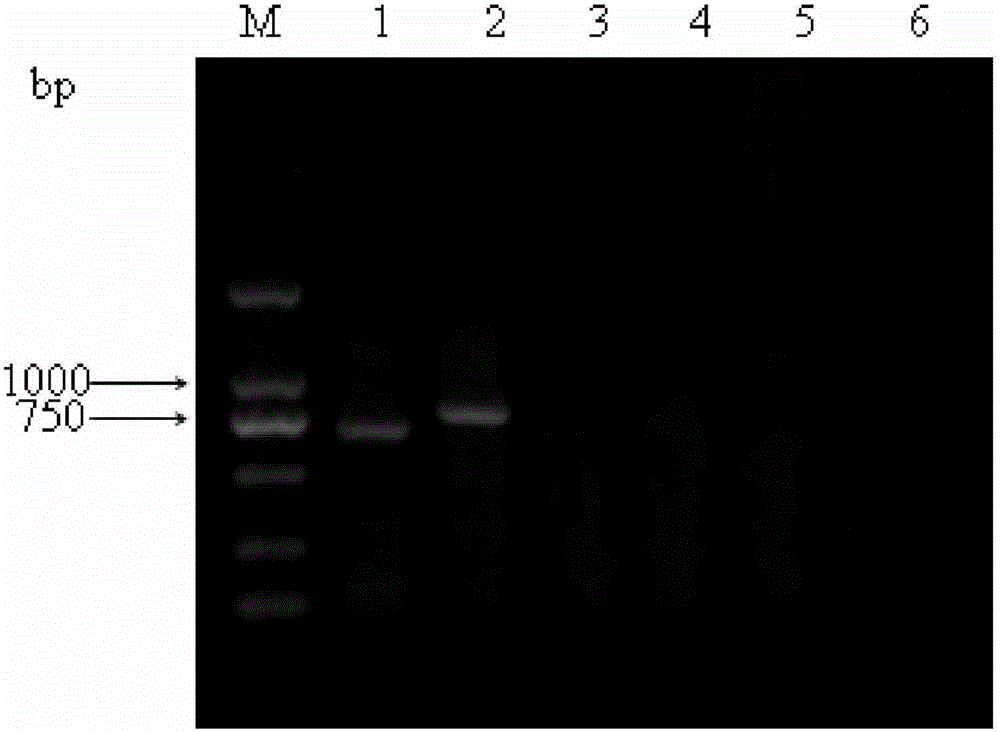Porcine reproductive and respiratory syndrome virus nano PCR differential diagnosis kit and detection method thereof
A respiratory syndrome and differential diagnosis technology, which is applied in the detection field of porcine reproductive and respiratory syndrome virus, can solve the problems of insufficient amplification efficiency and non-specific product amplification in complex systems, and achieve the purpose of improving specific amplification yield, The effect of reducing the residence time and shortening the time
- Summary
- Abstract
- Description
- Claims
- Application Information
AI Technical Summary
Problems solved by technology
Method used
Image
Examples
Embodiment 1
[0032] Embodiment 1 A kind of nano-PCR differential diagnosis kit that detects porcine reproductive and respiratory syndrome virus The best embodiment
[0033] The kit of this example includes: (1) Reagents for extracting porcine reproductive and respiratory syndrome virus RNA: TRIzolLSReagent, chloroform, isopropanol, 75% ethanol; (2) reverse transcription reagents: 5×reverse transcription buffer, concentration dNTPMixture at 2.5mM, M-MLV reverse transcriptase at a concentration of 2.5U / μL, RNase inhibitor at a concentration of 30U / μL, and reverse transcription primers; (3) Nano-PCR reaction reagents: 2×NanoPCRMix, upstream Primers, downstream primers; (4) Others: positive control and nuclease-free water. Among them, 2×NanoPCRMix consists of DNA polymerase, 2×NanoPCRbuffer and dNTPMixture, and the positive control is to inoculate Marc-145 cells with the classic strain of porcine reproductive and respiratory syndrome virus and the highly pathogenic strain respectively, and col...
Embodiment 2
[0036] Embodiment 2 Non-diagnostic purpose Distinguishing the method of porcine reproductive and respiratory syndrome virus with nano-PCR method
[0037] The detection method of this example uses the kit in Example 1. The lungs, lymph nodes, spleen, and kidneys of dead pigs were taken as samples to be tested.
[0038] The detection method of this embodiment comprises the following steps:
[0039] 1. The specific steps of virus RNA extraction are as follows: (1) After cutting the sample to be tested, add normal saline according to the mass volume ratio of 1:5 and grind evenly, centrifuge at 3000-5000rpm for 5-10 minutes, take the supernatant, and take the supernatant clear. (2) Take 250 μL of the above-mentioned treated samples and the positive control respectively, add 750 μL TRIzolLS Reagent, shake vigorously for 2 minutes, and place at room temperature for 10 minutes. Add 250 μL of chloroform, shake vigorously for 15 s, leave at room temperature for 10 min, centrifuge at ...
Embodiment 3
[0044] Example 3 Specificity Test of Porcine Reproductive and Respiratory Syndrome Virus Nano-PCR Differential Diagnosis Method
[0045] According to the method of Example 2, highly pathogenic porcine reproductive and respiratory syndrome virus (HP-PRRSV), classical strain porcine reproductive and respiratory syndrome virus (C-PRRSV), classical swine fever virus (CSFV), porcine round Cyclovirus type 2 (PCV2), porcine pseudorabies virus (PRV), and porcine boca virus (PboV) were amplified to test the specificity of the nano-PCR method. The above amplification products were analyzed by 1% agarose gel electrophoresis. The result is as figure 2 As shown, the highly pathogenic porcine reproductive and respiratory syndrome virus amplified a band of 691bp in line with the expected size, and the classical strain of porcine reproductive and respiratory syndrome virus amplified a band of 781bp in line with the expected size , while the other 4 kinds of porcine virus nucleic acid did n...
PUM
| Property | Measurement | Unit |
|---|---|---|
| particle diameter | aaaaa | aaaaa |
Abstract
Description
Claims
Application Information
 Login to View More
Login to View More - R&D
- Intellectual Property
- Life Sciences
- Materials
- Tech Scout
- Unparalleled Data Quality
- Higher Quality Content
- 60% Fewer Hallucinations
Browse by: Latest US Patents, China's latest patents, Technical Efficacy Thesaurus, Application Domain, Technology Topic, Popular Technical Reports.
© 2025 PatSnap. All rights reserved.Legal|Privacy policy|Modern Slavery Act Transparency Statement|Sitemap|About US| Contact US: help@patsnap.com



